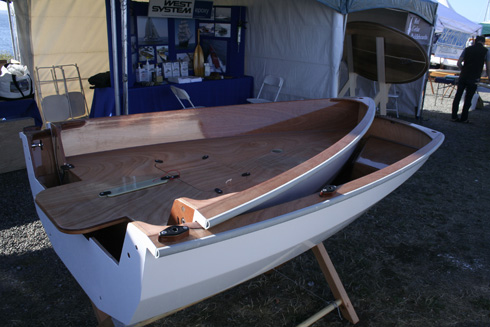A few years back at the marvelous Wooden Boat Festival in Port Townsend, Washington (held every September), I was reminded of the hidden dangers of boat shows. I was sitting in the cockpit of a custom Ed Monk design offered for sale and had forgotten that I had a mortgage and a job that required some semblance of working at an office.
It’s set up for a single-hander, the owner said. The owner prior to him had sailed it all over the Pacific. I caressed the freshly varnished tiller. It seemed to fit my hand perfectly. I poked around the v-berth workshop, which in my view is the proper use of V-berth on a small cruising boat. It was a gem, with custom-fitted drawers for tools and spare hardware.
Had not the cannon shot signaling the start of the classic schooner race awakened my superego, my kids’ college funds would be in even grimmer shape today. I later realized I’d violated the first rule for attending a boat show: Never go alone. Without a clearheaded companion to talk sense into me, my weakness for boats and dreams of the sea was exposed, ripe for exploitation.
Boat Show Survival
With the winter show season kicking into gear in our neighborhood this month—first with the St. Petersburg Boat Show, followed by the Miami International Boat Show—I offer these tips to sailors like myself who are prone to boat-show seductions. Having parted with a good share of my wages on unnecessary accessories at various shows, I am clearly no expert on this, so if you have any other advice to share, please do.

- Relax. Arrive for opening day, usually a weekday, so you can set an easy pace. By the time the weekend throngs arrive, vendors have little time for a leisurely chat. Plot the stalls or boats you want to see (download the show map online beforehand), but leave some time for browsing. For big-ticket items, save your purchase for the last day of the show, when prices—especially on hard to transport items—are often negotiable. (You can often negotiate for the advertised boat-show discount long after the show.)

- New is different, not necessarily better. When the next best thing is proudly unveiled at the show, remember that sailors have been safely, happily crossing oceans for decades, long before this new gadget existed. Some of the best gear is still found at used gear chandleries. And some of the Next Best Things haven’t had enough real-world testing to prove their merit.

- Eat well. Boat show food is a mixed bag-on par with the county fair. Plan ahead and pack a lunch, or exit midday to sample the local specialty at a nearby restaurant. The best places are often a block or two off the waterfront.

- Study the details. Even if you are not in the market for a new boat, take a spin around the docks for ideas or products you can use for your own boat. Take pictures; ask discreet questions. The same applies to the gear stalls. Many products you see can be fabricated at home for much less.
- Seek out the experts. The gurus of sailing often gather at boat shows, either to represent a product, sell books, or lecture on their favorite topic. Track them down at their booth, shower them with praise, buy their book, then pepper them with questions.
- Attend the right seminars. Not all boat show seminars are created equal. The first five minutes of a talk will usually make clear if it’s a marketing pitch or a worthwhile lecture. Sit near an aisle where you can walk out without causing a stir. Look for speakers with standout resumes, or more than just one book title behind them.

- Arrange a test sail (or row). Many dealers offer test sails on the days prior to or after the boat show. These show tests are often brief, however, and the wind on that day may not reveal the boat’s strengths or flaws, but it is often enough to recognize what options you might want-or not need.

- Beware of the gleam. Remember that these boats are in pristine, show condition, and sitting in a calm marina. As you admire the nine coats of varnish on the caprail, remember the effort it took to achieve that shine. Look beyond the pretty flowers on the dinette table for the things that matter—grippy non-skid, plenty of handholds, systems that are accessible for servicing, sensible running rigging, and so on.

- Steer clear of pirates. Every show has a few sketchy stalls selling plastic junk that will self-destruct the moment you get home. Look for companies with a history in the marine industry; cast a skeptical eye upon the rest.

- Have fun; make a friend. The after-hours parties are a breeding ground for bad dancing and embellished sea stories, but they are a great opportunity to meet people who share your passion for boats. The long-time cruisers whose advice you seek are usually easy to spot. Know them by their weathered boat shoes, rumpled clothes, and tote bags full of parts catalogs.








































All of your advisories are great. The seminar escape route one in particular. Re point #1, I might add that while browsing the aisles (or slips), avoid eye contact with the vendor, esp. during a weekday when traffic is light, unless you really want to engage with the person. Otherwise, you may end up in a tedious and possibly time-consuming chit chat – you want to be polite – when the other vendors at the show more on your mind warrant your time and attention.
You gave some good advice. But the shows conflict with my haul-out and beginning of bird hunting season.
Do you still keep a boat at Marquette?
Well written, but entirely incorrect. If we were not such fools about boats we’d never get our first or find the need to move to something better, and you’d be out of work.
Wear the most comfortable shoes you have and drink lots of water.
Having been a Volunteer for the Port Townsend Wooden Boat Festival for 14 years I say Thanks for all the Advice but I also say, to each his own. I am a part of the Festival and also the Adventure Races in June for months every year, not just the few days they are going on and I talk about them YEAR ROUND. #1 – STAY HYDRATED, #1 – Eat, #1 – Wear VERY Comfortable shoes & Rest WHEN NEEDED or cool off in our Paddle Board Pool out on the Point. See y’all in 1 week!!!